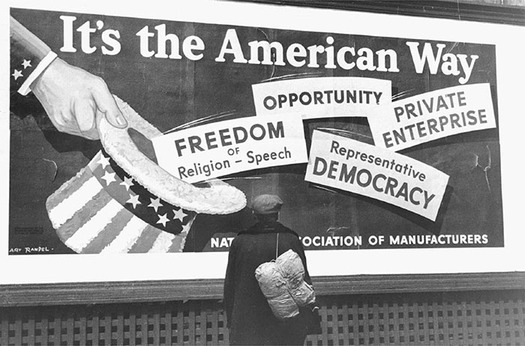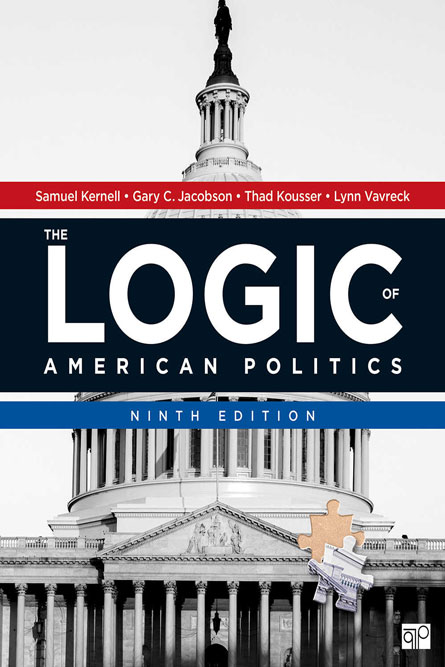The Logic of American Politics 9th Edition citation
Author(s): by Samuel H. Kernell (Author), Gary C. Jacobson (Author), Thad Kousser (Author), Lynn Vavreck (Author)
Publisher: CQ Press; 9th edition (April 4, 2019)
ISBN: 9781544322995


Preface to The Logic of American Politics 9th Edition
Donald Trump’s election and his first two years in office seem only to point out the illogic of American politics. Since writing this book’s last edition, shortly after the 2016 election, America’s politics has been in continuous tumult. The question we confront as we take the Trump presidency into account asks, does Donald Trump’s election and first two years in office break the mold, requiring us to rethink Logic ’s approach to the systematic forces and processes that govern the play of politics in Washington and across the nation? Perhaps not. The tumultuous events might represent the proverbial “exception that proves the rule.” If the latter, Trump’s election and presidency would allow us to glean new insights into American politics in other political actors’ responses to Trump’s unconventional behavior. Answering this question lies at the heart of this revision.
Obviously, assessment of the extraordinary 2016 election and the 2018 midterms are major topics of Chapter 11 ’s coverage of voting and elections, and sizing up Trump’s first two years in office occupies much of the attention of Chapter 7 on the presidency. In both we seek to square the Trump years with the stable systematic forces at work in both arenas. But this question pervades every other chapter as well. We close Chapter 2 (“The Constitution”) by considering the proliferation of contentious separation of powers issues that in some instances preceded the Trump presidency but that his policies have made more salient and problematic. Chapter 3 ’s coverage of federalism introduces the Democratic and Republican cadres of state attorneys general signed on to lawsuits challenging or supporting administration policies according to their partisan alignment with the president.
Chapter 4 reports on the ongoing tribulations over the still unresolved Deferred Action for Childhood Arrivals (DACA) policy affecting several hundred thousand children brought into the country illegally. With Republicans controlling both chambers of the 115th Congress and Trump in the White House, the Republicans were poised to fulfill their dream of repealing Obamacare; Chapter 6 explains why they could not. We learn in Chapter 8 just how extensive presidents’ administrative authority is, in chronicling President Trump’s directions to administration officials to roll back the Obama administration’s extensive formal and informal regulations of businesses and state administration of federal programs. Chapter 9 finds the federal judiciary giving new meaning to activism in which an increasing number of district judges in the states weigh in on national policy by issuing national injunctions, again lining up consistently with the preferences of the party of the president who appointed them. Chapter 10 takes a close look at public opinion, paying particular attention to issues on which it has changed over the last several decades but also to issues on which opinion has been remarkably stable. Chapter 12 notes how intense opposition to Trump and his Republican partners energized Democratic partisans in 2018, especially women, producing a dramatic upsurge in activism, unprecedented levels of campaign spending, the highest midterm turnout in more than a century, and a Democratic House majority.
Chapter 13 shows how students from Parkland, Florida, adopted and refreshed the techniques of interest group influence to put pressure on President Trump and Congress to make progress to reduce gun violence. Chapter 14 addresses the ever-changing role of the media in American politics. In this edition, we separate media into legacy media, digital-only media, and social media and discuss how the news is produced and consumed for each type. We also examine the role of fake news—all while addressing the threat to democracy that comes when the president refers to legacy news outlets as “fake news” and labels media “the enemy of the people.” And in Chapter 15 , we use the logic of collective action to explain why President Trump’s tax reform of 2017 succeeded in passing, whereas prior efforts by President Obama and by Republican leaders in Congress had failed.
One of the themes of The Logic of American Politics is that, alongside the outsized personalities that inhabit Washington, D.C., and the idiosyncratic events that appear to drive it, systematic forces remain at work. The book’s goal is to help students understand these forces and to see how they shape the choices of political leaders today. We want to help readers discern the rationale embedded in the extraordinary and complex array of American political institutions and practices. To accomplish this goal, we analyze political institutions and practices as (imperfect) solutions to problems facing people who need to act collectively. We highlight recurring obstacles to collective action in various contexts to illuminate the diverse institutional means that American politicians have created to overcome them. These obstacles include the conflict over values and interests, the difficulty of aggregating individual preferences into collective decisions, the need for coordination, and the threat of reneging implicit in every collective undertaking. Stable political communities strengthen their capacity to act collectively and reduce the costs of doing so by fashioning appropriate institutions. These institutions feature majority and plurality rules and procedures that convert votes into representation, delegate authority to agents, and permit some institutional actors to propose courses of action while allocating to others the right to veto proposals. Throughout the book we emphasize the strategic dimension of political action, from the Framers’ tradeoffs in crafting the Constitution to the efforts of contemporary officeholders to shape policy, so students can understand current institutions as the products of political conflicts, as well as the venues for resolving them.



mattpiquedinterest –
Verified Purchase